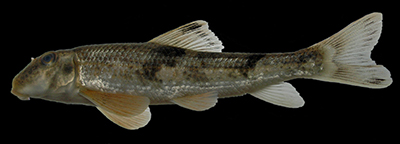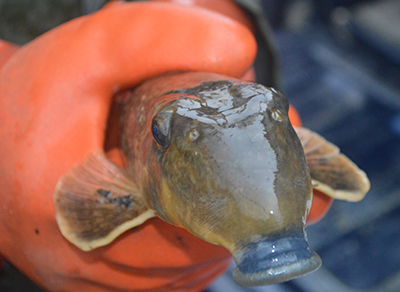 Fisheries Blog
Fisheries Blog
Although many of us know about the common game species, the non-game species are less well known — not surprising since it is tough to observe fish in their natural habitats. Illinois has over 200 fish species occupying a wide variety of waters, ranging from large rivers to small streams, and from small ponds to Lake Michigan. Our non-game species blog is highlighting those lesser-known Illinois species. We hope you enjoy the pictures and the information on their life histories, distribution, family ties, and other interesting facts about this fascinating group of animals.
Northern Hogsucker
As you may have guessed, Northern Hogsucker is in the sucker family known as Catostomidae, derived from Greek, meaning “mouth below.” The subterminal mouth is characteristic of this family containing 75 species worldwide, most of which are in the Western Hemisphere. Midwestern and Southeastern United States have the greatest diversity of Catostomidae. By the way, don’t confuse Suckers with the non-native Common Carp. Some species of Sucker vaguely resemble Common Carp, which have barbels on their mouth and are actually in the Cyprinidae, or Minnow family. Suckers are way cooler and, unlike Carp, are mostly quite intolerant of pollution and siltation
 What’s in a name? Well, Hogsucker is strange enough, but let’s look at the scientific name: Hypentilium nigracans. Hypentilium is Greek, meaning “below five lobes” referring to structure of the lower lip; nigracans, which means “blackish” in Latin, refers to the dark black mottled areas found across the dorsal surface. Other common names include Hog Molly, and Box Head.
What’s in a name? Well, Hogsucker is strange enough, but let’s look at the scientific name: Hypentilium nigracans. Hypentilium is Greek, meaning “below five lobes” referring to structure of the lower lip; nigracans, which means “blackish” in Latin, refers to the dark black mottled areas found across the dorsal surface. Other common names include Hog Molly, and Box Head.
Northern Hogsuckers are one of the most distinguishable species in the State due to its large, concave-shaped head, large protruding lips covered with small bumps, and large pectoral fins. It is also rare among the Sucker family in having a distinct pigmentation pattern consisting of five dark bands, or saddles along the back (sometimes faded), with dark speckles across the entire body. The ventral (bottom) surface is flattened, especially near the head. The body narrows considerably toward the tail region, giving this unusual fish an out-of–proportion appearance. Adults are typically in the 150 to 300 mm length range, with females generally growing larger. Individuals up to 500 mm can be found in larger rivers.
The preferred habitat of the Northern Hogsucker is high to moderate gradient streams with gravel or cobble substrate. Their flattened body and large pectoral fins help them stay in place and navigate these areas of higher water velocities. They can be found in streams ranging from small creeks to larger rivers, if riffle habitat is present. The most abundant populations seem to occur in larger-sized creeks and small rivers. This species is very sensitive to siltation and channelization. Their food consists of a variety of aquatic invertebrates, including small shelled animals. Most individuals are sexually mature by age three. Northern Hogsucker spawns in the late spring over medium-sized gravel at the downstream end of riffles with higher water velocities. Although no nest building occurs, the larger female is often closely escorted by multiple males (3 – 10) for a prolonged period, prior to the extrusion of the eggs.
 The range of this sensitive species has been affected by channelization, urban development, and dams throughout the State. If you find Northern Hogsucker, you can be reasonably sure the stream is in pretty good shape. They are still relatively common in Northeastern Illinois (outside of the Chicago urban area) and in East-Central Illinois. They are absent or much less common in the Western and Southern areas, with the exception of a few streams in Shawnee National Forest. As indicated on the statewide distribution map (https://www.inhs.illinois.edu/files/2513/3942/6024/hy_nigrica.gif), they are less common than they used to be, especially in Central Illinois, due to siltation and channelization.
The range of this sensitive species has been affected by channelization, urban development, and dams throughout the State. If you find Northern Hogsucker, you can be reasonably sure the stream is in pretty good shape. They are still relatively common in Northeastern Illinois (outside of the Chicago urban area) and in East-Central Illinois. They are absent or much less common in the Western and Southern areas, with the exception of a few streams in Shawnee National Forest. As indicated on the statewide distribution map (https://www.inhs.illinois.edu/files/2513/3942/6024/hy_nigrica.gif), they are less common than they used to be, especially in Central Illinois, due to siltation and channelization.



